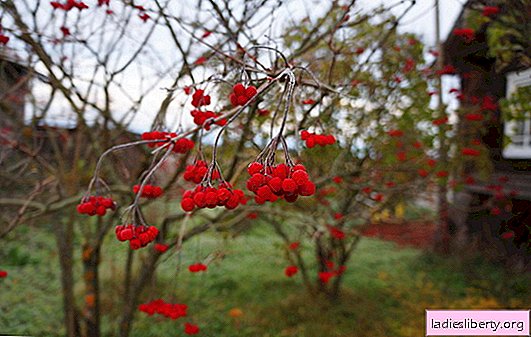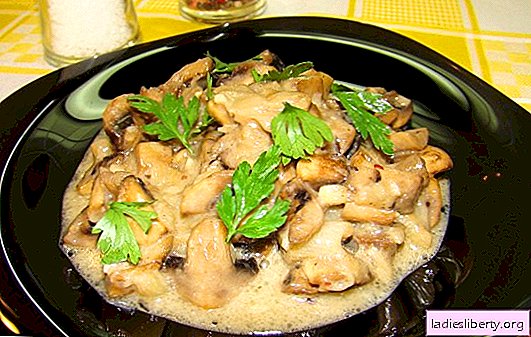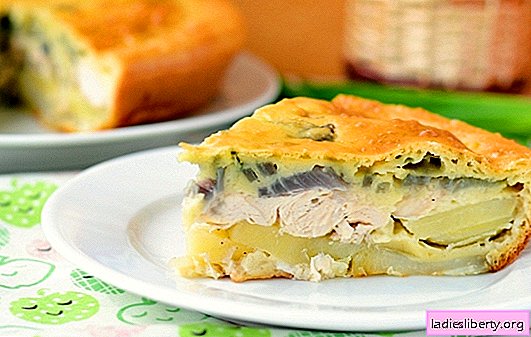
Unfortunately, it is very difficult to determine where the viburnum comes from, but this plant is quite widespread in subtropical and moderate latitudes: the Caucasus, Ukraine, Siberia, Russia and many other countries.
Guelder-rose differs in good shade resistance and moisture lovingness therefore in the nature it quite often meets in a dense forest, cutting down, on coasts of reservoirs.
Guelder-rose belongs to a number of winter-hardy, long-lived and early-growing plants, bringing the first crop with the onset of the fourth year. The most common is a shrub form.
Viburnum is not a demanding plant, but with sufficient humidity and open area brings a good harvest - up to 15 kg from one shrub.
The growing region is considered a temperate climate in Europe, Western Siberia, Central and Asia Minor.
This article has a guide on planting viburnum, its care with a photo. What will help to deal with the question of interest in detail
Features of growing various varieties of viburnum
On the Crimean South coast, viburnum blooms very early - already starting in mid-December, but the peak of pink and snow-white flowering occurs in May. There are quite a few varieties of viburnum and each has its own growing characteristic:
1. Kalina "Avabuki". This stately variety of viburnum was bred in Japan, as well as in South Korea. Avabuki refers to winter-hardy varieties of viburnum. At high temperatures, only foliage is damaged. On the southern coast of Crimea during very cold winters, the tips of young shoots may freeze;
2. Barkwood. Propagated by cuttings, this variety of viburnum requires shading and drained soil;
3. Bodybuilding viburnum. Cutting reproduction. Viburnum prefers a lot of sun, and also needs loosened and well-moistened soil;
4. Pride. The birthplace of this variety is Europe, North Africa and Southwest Asia. This variety has high frost resistance, tolerates temperatures up to -35C. The plant adapts perfectly to various conditions, like drought and high humidity:
5. David. This variety of viburnum is also propagated by cuttings. The plant prefers more shady places with moist soil with good fertility;
6. Viburnum fragrant. It has low frost resistance, tolerates only up to -5C. Propagated by cuttings. You need to plant in putrid, acidic, fertile soil;
7. Kalina Karlsa. This variety is widely used in Europe as a decoration for the garden, it is very frost-resistant (-30С). The plant is not picky about lighting, it is necessary to plant on the drained soil;
8. Brown-leafed viburnum. The variety was bred in China, where it is very popular. The plant does not withstand low temperatures (up to -5C), it is necessary to plant in acidic soil.
In order for viburnum planting and care to be correct, the article contains photos.
Planting viburnum and care with a photo
The plant needs well-lit and semi-shady places. Viburnum is not a finicky plant, if you plant a bush of viburnum in a well-moistened soil, the plant will certainly please you with wonderful flowering and abundant harvest. You can plant viburnum with the onset of spring and autumn. Optimally, it is considered a landing in early April.
In order to plant a plant, first of all, you need to dig a fairly deep hole, up to about 50 cm. Next, a nutrient mixture is poured into the hole, which will feed the plant for 3 years. The mixture consists of humus, leaf and garden soil, peat and complex mineral fertilizers, which include potassium, phosphorus and nitrogen.
A young seedling of viburnum should be placed in a hole in the loop mixture, while it is important that the root neck is deepened by 5 cm. This stimulates the growth of new roots that will strengthen the viburnum in the soil and help it adapt quickly.

After this, the seedling should be covered with soil and pour warm water. In order to protect the root system, a mulching mixture must be poured around the seedling.
Plant care includes several stages:
1. Watering viburnum. The planted young seedling must be watered with the onset of the evening, the soil should be soaked about 40 cm. An adult plant needs to be watered during the growing season, and during the harvest.
2. Top dressing. With the onset of spring, around the plant, the soil must be fertilized with 2 tablespoons of urea. Before the viburnum begins to bloom, the soil needs to be fertilized with 2 tablespoons of potassium sulphide or wood ash. In summer, viburnum must be fed with complex mineral fertilizers, 60 g are needed. After 2 years, with the onset of autumn, viburnum must be fertilized with rotted manure and combined phosphorus-potassium fertilizers. During drought, to achieve the effect, the fertilizer must be diluted with water.
3. Crown shaping and trimming. For a year, the branches of viburnum can grow by more than 40 cm. Pruning is necessary with the onset of spring, it is necessary to form a crown, remove unnecessary or painful branches. For fully matured, not young plants, it is recommended to perform anti-aging pruning, but this procedure must be performed when the bush has reached the age of 6 years. For this, obsolete shoots must be cut to the root. But you need to leave about 15 branches. If the bush is very weak, gives few fruits, it must be cut to the root to 20 cm, which stimulates it to active growth.

Pests and diseases of viburnum, methods of cure
The main pests of viburnum include:
1. Viburnum leaf beetle

Beetle, light brown, up to 6 mm in size. With the onset of August, begins to lay eggs in recesses of shoots of plants, in shocking quantities - up to 700 pieces. In winter, young shoots dry out, but laid eggs calmly overwinter. In May, eggs mature and larvae hatch from them, and immediately begin to destroy young shoots and leaves. In June, the larvae burrow into the soil for pupation. Already with the onset of July, beetles appear that eat leaves.
How to deal with viburnum leaf beetle?
It is necessary to prune young shoots in the autumn and spring, and you must immediately remove the leaves on which there are larvae;
In the spring, even before the leaves bloom, the bush must be processed: Fafanon, Karbofos, Acttelik, Aktara. And you also need to take twice Intavir with an interval of up to 10 days.
2. Viburnum aphid

The leaf aphid is black. Dimensions reach as little as 7mm. Of the eggs that have successfully wintered, in spring larvae hatch. Aphids are able to actively reproduce actively, feed on plant juices. The leaves of viburnum begin to twist, deform and dry out.
How to deal with viburnum aphids?
It is necessary to perform the first treatment before the buds bloom, this will significantly reduce the number of eggs that were able to winter. Drugs must be alternated: Fufanon with Karbofos. It is also possible to use biological devices: Sparks, Intavira, Acarin.
3. Cap Mole

The method of disposal is no different from viburnum aphids. It is necessary to prune young shoots, with the onset of spring, and spray the bush with Karbofos, a solution of 90g / 10l of water.
4. Comma scale

To get rid of this pest, it is necessary to do preventive pruning in the fall and spring, spray the viburnum with Karbofos solution, and with the onset of August spray with Fufanon and Spark.
What are the diseases of viburnum? How to deal with them?
Viburnum is considered a water-loving plant, but if the weather is too rainy, the moisture level is excessively elevated, then various fungal diseases can form on young shoots, one of the most common:
Gray rot;
Phyllostic spotting;
Fruit rot;
Powdery mildew.
With increased humidity, dark spots and a bloom of mushroom sporulation begin to form on the leaves. You need to get rid of this, since this is fraught with a slowdown in the growth of viburnum, a deterioration in tissue transpiration, young shoots inevitably begin to dry out. Also, the result of increased humidity is abundant premature subsidence of foliage. As a result, the plant will be poorly prepared for the winter period, there is a high probability of drying out of the plant or a reduced yield with the onset of summer, as the infection continues to develop in plant debris.
What are the methods of combating diseases?
From spotting and powdery mildew, there is such a prevention:
Throughout the season, the plant must be pollinated with infusion of tobacco, garlic and onions. This composition will not affect the taste and quality of berries;
It is imperative to perform sanitary pruning, and the removal of plant debris and thinning of bushes is also considered mandatory. This will significantly help to stop the development of infection, as well as destroy its foci.
From putrefactive damage to the leaves, before the buds open, and also after flowering, viburnum needs to be treated with a Bordeaux composition. Also effective are such drugs - Khom, Abiga-Peak.
How to collect and store viburnum
Harvesting viburnum should be carried out only in dry weather, and it is very careful to avoid damage to berries. You need to store viburnum in the form of jam, frozen or dried berries, while the beneficial properties of viburnum are not lost at all. Before freezing viburnum, it must be thoroughly washed and dried. You need to freeze in specialized packages. If there is an accelerated freezing function in the freezer, it must be turned on for 30 minutes. This will help the berries to avoid deformation and preserve their structure. The initial stage when drying the berries is considered to be drying in the street, in the sun a couple of days, the final stage, I reach the berries in the oven at 60C. Already dried berries must be separated from the stem and placed in a cloth bag. This storage method will prevent steaming.











